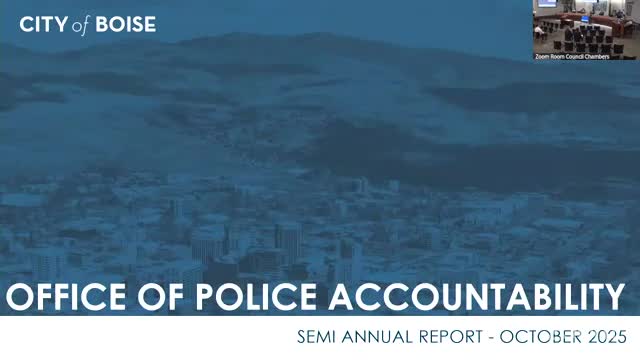Office of Police Accountability unveils interactive use‑of‑force dashboards, reports fewer deadly‑force incidents in 2025 to date
October 21, 2025 | Boise City, Boise, Ada County, Idaho
This article was created by AI summarizing key points discussed. AI makes mistakes, so for full details and context, please refer to the video of the full meeting. Please report any errors so we can fix them. Report an error »

Nicole McKay, director of the Office of Police Accountability, and OPA data analyst Lexi Whitmore presented OPA’s semiannual report to the Boise City Council and demonstrated a newly posted interactive data dashboard that shows use‑of‑force incidents, officer demographics, a geographic map of force events and time trends for 2023–24.
Whitmore walked council members through dashboard features and definitions, explaining that "show of force means pointing a weapon at a subject such as aiming a taser, while use of force means discharging a weapon or making physical contact with a subject such as actually firing the taser." She said the public dashboard allows users to filter by year, call type and show‑of‑force versus use‑of‑force, to drill down by demographic groups, and to view a map and time‑of‑day trends.
McKay summarized OPA casework and findings for the period. OPA recorded 90 incoming contacts through September, of which 46 met the agency’s definition of a complaint (allegations that meet jurisdictional requirements and, if proven, would violate policy or law); 42 were classified as informational contacts. "All complaints are investigated," McKay said, and emphasized that informational contacts do not meet jurisdictional thresholds and are handled differently. Of the complaints in the period, three were sustained (two for failure to timely activate body‑worn cameras and one for failure to timely follow up on potential evidence). McKay said four complaints fell outside OPA’s 90‑day filing time limit but that OPA may waive that limit for extenuating circumstances.
On critical incidents, McKay said OPA has investigated six use‑of‑deadly‑force incidents in 2024; four investigations are complete and three reports have been released publicly. One investigation, referenced by name in the meeting as the Willski matter, remains withheld pending criminal proceedings. McKay also noted that there have been no use‑of‑deadly‑force incidents reported to date in 2025.
Council members spent time using the dashboard during the presentation and praised the level of public access. Several members asked follow‑up questions about outliers and possible explanations for patterns; McKay said OPA will use the dashboards as a foundation for further analysis, including benchmarking Boise against peer agencies and analyzing the impact of BPD’s expanded behavioral health teams. She said one near‑term goal is shortening the time between an incident and OPA’s public release of critical‑incident reports where possible.
Council members and OPA praised collaboration with Boise Police Department trainers and staff. McKay said OPA has been invited to observe BPD scenario and promotional training and that BPD has used OPA recommendations in block training. McKay also listed recent outreach and training collaborations — including hosting an international delegation and meeting with leaders setting up oversight offices in other cities — and said OPA staff will continue to refine dashboard capabilities based on council questions.
Whitmore walked council members through dashboard features and definitions, explaining that "show of force means pointing a weapon at a subject such as aiming a taser, while use of force means discharging a weapon or making physical contact with a subject such as actually firing the taser." She said the public dashboard allows users to filter by year, call type and show‑of‑force versus use‑of‑force, to drill down by demographic groups, and to view a map and time‑of‑day trends.
McKay summarized OPA casework and findings for the period. OPA recorded 90 incoming contacts through September, of which 46 met the agency’s definition of a complaint (allegations that meet jurisdictional requirements and, if proven, would violate policy or law); 42 were classified as informational contacts. "All complaints are investigated," McKay said, and emphasized that informational contacts do not meet jurisdictional thresholds and are handled differently. Of the complaints in the period, three were sustained (two for failure to timely activate body‑worn cameras and one for failure to timely follow up on potential evidence). McKay said four complaints fell outside OPA’s 90‑day filing time limit but that OPA may waive that limit for extenuating circumstances.
On critical incidents, McKay said OPA has investigated six use‑of‑deadly‑force incidents in 2024; four investigations are complete and three reports have been released publicly. One investigation, referenced by name in the meeting as the Willski matter, remains withheld pending criminal proceedings. McKay also noted that there have been no use‑of‑deadly‑force incidents reported to date in 2025.
Council members spent time using the dashboard during the presentation and praised the level of public access. Several members asked follow‑up questions about outliers and possible explanations for patterns; McKay said OPA will use the dashboards as a foundation for further analysis, including benchmarking Boise against peer agencies and analyzing the impact of BPD’s expanded behavioral health teams. She said one near‑term goal is shortening the time between an incident and OPA’s public release of critical‑incident reports where possible.
Council members and OPA praised collaboration with Boise Police Department trainers and staff. McKay said OPA has been invited to observe BPD scenario and promotional training and that BPD has used OPA recommendations in block training. McKay also listed recent outreach and training collaborations — including hosting an international delegation and meeting with leaders setting up oversight offices in other cities — and said OPA staff will continue to refine dashboard capabilities based on council questions.
View full meeting
This article is based on a recent meeting—watch the full video and explore the complete transcript for deeper insights into the discussion.
View full meeting